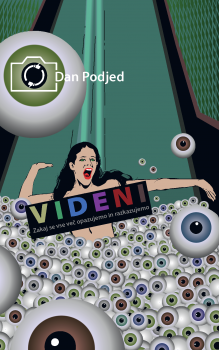Videni. Zakaj se vse več opazujemo in razkazujemo
The book ('Seen: Why We Like Watching Others and Being Watched in Return') looks at the all-seeing eyes that observe us from computers, smartphones, tablets and other devices. It reveals what online search engines know about us and how we can become more visible by sharing contemporary auto-portraits – selfies. The book shines a spotlight on the “show masters”, from celebrities to politicians, who depend on their visibility and public appearances for their livelihood. In addition, it explains why the naked human body has become so attractive that millions enjoy the images and videos of people who put their private parts on display. After reading this book, some readers will cover their smartphone and laptop cameras, while others will start thinking about how they can share their selfies more effectively. Because what the book is ultimately saying is that in the contemporary world, we may not exist at all if no one sees us.
The author looks at the different ways of mutual supervision and display which have transformed and marked the contemporary society. They are most closely connected with the development and operation of various forms of surveillance technologies that originated much earlier than in the 21st century. A special control building is showcased, the Panopticon, which was conceived in the 18th century by the English philosopher and lawyer Jeremy Bentham. Based on its concept, it is possible to explain different types of surveillance and observation, and how different devices, utilities, and systems intertwine in so-called surveillant assemblages. The author also presents the good and the bad that is brought by the omnipresent regards. Research shows that sometimes it is enough to feel that people look at each other to become more generous, cautious, precise, attentive, and show more solidarity.
The author then focuses on Internet search engines that have turned into a global oracle, offering answers to a multitude of questions and scouring information about everything that interests people. Google and other search engines not only provide and analyze information but also use it for the benefit of the company that has developed them. It is especially important that they inform the decisions of individuals in this way and, if necessary, redirect the social stream of consciousness. With advanced data analysis algorithms, everything that was the task of the most effective secret institutions in totalitarian regimes in the past is being done much more efficiently by these companies now; they collect and analyze facts about how people live and monitor whether they might be in violation of the rules.
The book also presents modern-day self-portraits – selfies. Their significance lies in the fact that people do not keep them for themselves, but rather spread them over the web, thus contributing a fragment into the complex mosaic of billions of self-portraits that people publish every year on the web. Some of them are particularly active, for example musicians, athletes, and even politicians. Among them is also the Slovenian president, who regularly publishes selfies and other photographs, where he tends to be in the center of the view, through Instagram. Those who want to compete with such a well-known individual and become more noticeable must do something truly unusual, exceptional, surprising, risky, or even life-threatening.
Extreme exhibitionists on the web are instant celebrities. The spotlight is put on Slovenian famous individuals Damjan Murko, Fredi Miller, Artur Štern, Urška Hočevar Čepin, and Denise Dame. Their way of life, which feeds on the views of others, is compared to the celebrities from abroad – with the rich heiress Paris Hilton, who found stardom through a pornographic video more than because of her wealth, and with the president of the United States, Donald Trump, who has climbed to an important political position as a well-known businessman and a notorious media personality. The author explains how contemporary information and communication technologies enable such famous individuals to stand out from the crowd more successfully and much faster than in the past, as they can inflate their fame using smartphones and social networks, and develop their own news about themselves. Such self-promoting strategies are becoming more and more used even by athletes, scientists, artists, and other individuals: if they had to make their names through actions in the past, they can now achieve this with their image and beautiful words about themselves that they spread over the web.
This book also explores the industry of pornography, which is closely related to the wishes and needs of observing and displaying. The hidden interests of people who are browsing for such recordings are described, as they look at degraded and humiliated people and experience the need to see deeper into the body. A step even further from the naked people involved in the international pornographic spectacle is an internationally reputed exhibition of human bodies: they are not only naked, but they are also skinless and plastinated so that visitors can see all the soft tissues of the inside of the human body. Why are naked bodies, whether in pornographic films on the web or at the exhibition of plastinated people, so interesting that they are viewed by millions? And why are our watching needs satisfied only by the actual, authentic, real people, not plastic substitutes and acted out scenes? The answer hides deep inside people and in the need to see what is real, to know more about others and ourselves.
In the concluding chapter, the author presents to what worlds the desire to see more is leading. He presents possible scenarios for the future, in which many forms of control will either be consolidated or softened. The chapter also explains whether it is still possible to find the “oasis of peace,” that is, un-controlled corners where people can hide without being looked at by anyone.
Downloads

Series
License

This work is licensed under a Creative Commons Attribution-NonCommercial-NoDerivatives 4.0 International License.
